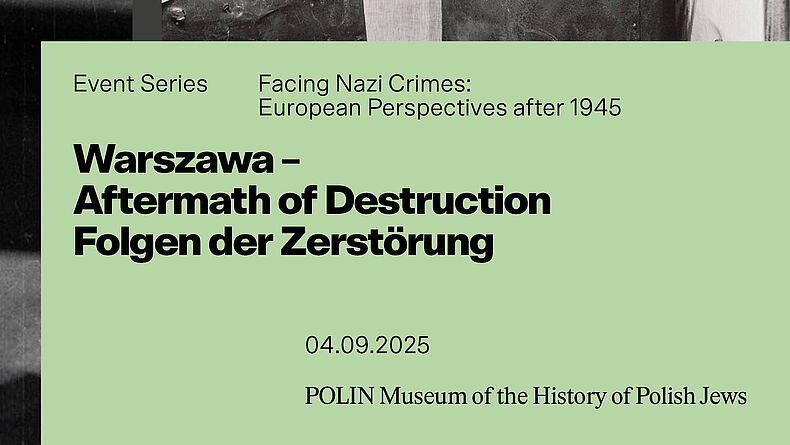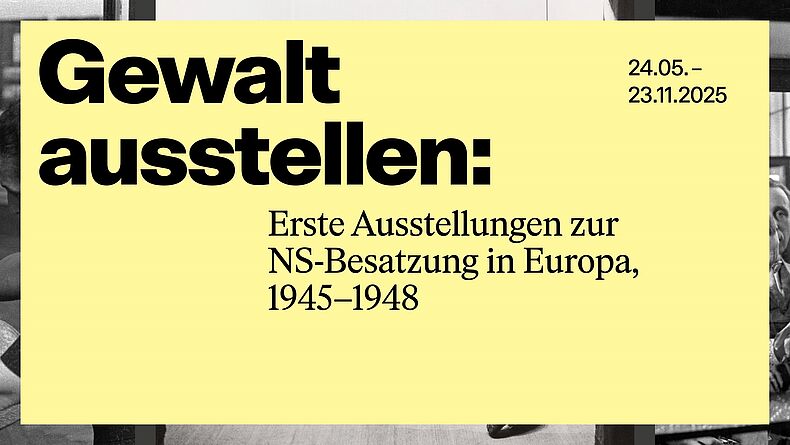Facing Nazi Crimes: European Perspectives after 1945
European Event Series on the exhibition “On Displaying Violence: First Exhibitions on the Nazi Occupation in Europe, 1945–1948” to be resumed on 4 September
Download
After the summer break, the European Event Series “Facing Nazi Crimes: European Perspectives after 1945” will launch the second half of its events. After the discussions in May and June 2025 that took place in London, Paris and Liberec, the series will continue in Warsaw, Bergen-Belsen and Berlin beginning on
4 September. The events are held in conjunction with the DHM exhibition “On Displaying Violence: First Exhibitions on the Nazi Occupation in Europe, 1945–1948”, which was developed jointly by the Deutsches Historisches Museum and the Documentation Centre “German Occupation of Europe in the Second World War”. The programme deals with the social and historical contexts of the exhibitions on Nazi crimes, which were presented in five European cities between 1945 and 1948. The final event will take place in Berlin in the Deutsches Historisches Museum on 8 October 2025.
At the events, international guests and members of the DHM exhibition team explore the relationship of the early exhibitions to the documentary, legal, political and historical deliberations about the German occupation and crimes at the time. How were the exhibitions received and what influence did they have on the culture of remembrance?
The admission-free event series will be streamed online and subsequently accessible on the Internet.
The next event takes place on Thursday, 4 September 2025 in cooperation with the German Historical Institute Warsaw and the Jewish Historical Institute in the POLIN Museum of the History of Polish Jews. In the politically unstable climate of the post-war period, two exhibitions about the Nazi crimes and occupation – “Warszawa oskarża” (Warsaw Accuses) and “Martirologye un kamf / Martyrologia i walka” (Martyrology and Struggle) – were organised in Warsaw between 1945 and 1948 which also shed light on the conflicting motives of the organisers. In light of the specific perspectives of a Central European country that was a major arena of the Holocaust and other German mass crimes, the question arises as to how the early controversial positions have continued to affect current discussions of these topics.
On the panel are Zuzanna Hertzberg (Warsaw), Maria Kobielska (Jagiellonian University Kraków), Agata Pietrasik (Freie Universität Berlin), Magdalena Saryusz-Wolska (Deutsches Historisches Institut Warschau) und Zuzanna Schnepf-Kołacz (Jewish Historical Institute).
Dates of the upcoming event series “Facing Nazi Crimes: European Perspectives after 1945”
Warszawa – Pokłosie zniszczeń | Aftermath of Destruction
Thursday, 4 September 2025, 6 pm, POLIN Museum of the History of Polish Jews
In cooperation with the German Historical Institute Warsaw and the Jewish Historical Institute
With Zuzanna Hertzberg, Maria Kobielska, Agata Pietrasik, Magdalena Saryusz-Wolska and Zuzanna Schnepf-Kołacz
In the politically unstable climate of the post-war period, two exhibitions about the Nazi crimes and occupation – “Warszawa oskarża” (Warsaw Accuses) and “Martirologye un kamf / Martyrologia i walka” (Martyrology and Struggle) – were organised in Warsaw between 1945 and 1948 which also shed light on the conflicting motives of the organisers. In light of the specific perspectives of a Central European country that was a major arena of the Holocaust and other German mass crimes, the question arises as to how the early controversial positions have continued to affect current discussions.
Polish with German interpretation
Bergen-Belsen – Survivors and Remembrance
Monday, 15 September 2025, 5.30 pm, Niedersachsen-Kaserne, Lohheide
In cooperation with the Bergen-Belsen Memorial
With Agata Pietrasik, Katja Seybold, Dan Michman and Elke Gryglewski
In 1947, survivors in the Bergen-Belsen Displaced Persons Camp organised the exhibition “Undzer veg in der frayhayt” (Our Path to Freedom). It provided remarkable insight into how the history of the Nazi occupation and the Holocaust was told from the viewpoint of Jewish DPs. What importance did the perspectives of the victims have for historiography and the culture of remembrance then and now?
English with German interpretation
Prior to the event there is the opportunity, starting at 3.30 pm, to participate in a guided bus tour to the grounds of the former Bergen-Belsen Displaced Persons Camp.
Berlin – Europäische Erinnerung? | European Memory?
Wednesday, 8 October 2025, 6.30 pm, Deutsches Historisches Museum
With Ljiljana Radonić and others
The first exhibitions about Nazi crimes were part of a Europe-wide phenomenon that came to a halt with the onset of the Cold War. To what extent can an examination of the discussions and confrontations of the post-war period be instructive for today’s culture of remembrance? What challenges are connected with a project of European remembrance in light of the collapse of the post-war order as well as current crises and wars? In what way are we again faced with the questions posed in the years 1945 to 1948?
In German
The event series takes place in cooperation with the Max Weber Foundation.
Admission is free to all events. Information about registration can be found under dhm.de/programme
Video recordings of the entire event series will subsequently be available on the DHM-YouTube-Channel and can also be later heard on the DHM-Soundcloud-Channel and the DHM-Spotify-Channel.
“On Displaying Violence: First Exhibitions on the Nazi Occupation in Europe, 1945–1948”
At the height of its power, National Socialist Germany ruled over almost all of Europe. Some 230 million people in what are now 30 countries lived under German occupation. How did the postwar societies process their experiences of violence and destruction resulting from the Second World War and the concurrent Nazi occupation? A previously overlooked but historically influential form of coming to terms with this desolation are the exhibitions that were organised throughout Europe immediately after the war. In times of social hardship, political instability, enduring violence, and uncertain future, they aimed to document and visualise the consequences of the Holocaust and the Nazi crimes. With “On Displaying Violence: First Exhibitions on the Nazi Occupation in Europe, 1945–1948”
(24 May–23 November 2025), the Deutsches Historisches Museum traces for the first time the history of this pan-European phenomenon, using the examples of early exhibitions in London, Paris, Warsaw, Liberec and Bergen-Belsen. The DHM exhibition is presented in cooperation with the Documentation Centre “German Occupation of Europe in the Second World War”. It is the view of the project that a joint European remembrance, and thus a joint European future, depends to a great degree on the shared knowledge of the history of the German occupation.
The exhibition focuses on the different forms and presentations with which the exhibition organisers – most of whom were themselves Holocaust survivors and victims of Nazi persecution – took up the themes of violence, resistance and perpetrators, as well as the loss of cultural heritage. This throws light on the different ideas about the future that were reflected in the early exhibitions. Rooted in the respective local and national contexts, the different visual languages of the time are analysed and the sources compared. The motivation of the participants and the effect of the exhibitions are examined, some of which travelled throughout Europe. Original objects, photographs, films, documents, artworks and multimedia presentations give the visitors a greater understanding of the challenges and backgrounds of this “first look back.”
Documentation Centre “German Occupation of Europe in the Second World War”
Between 1939 and 1945, Germany brought disfranchisement, suffering, destruction and death to large parts of Europe. The methods of warfare and the treatment of the civilian population constituted major crimes. The Shoah and the genocide of Sinti and Roma were unique in history. In the areas that suffered under German occupation, the violence is still felt today. To acknowledge this, the German Bundestag resolved to found a Documentation Centre in Berlin and entrusted the DHM with its realisation. The future centre will present the European dimension of the German occupation and provide room for commemoration. It will focus on the experience of the victims, particularly those groups that have received less attention.
Further information on the Documentation Centre under: dhm.de/zwbe
Press photos: Pictures are available in the press section of the DHM website.
Press accreditation Event Series: Please contact the press office at the relevant location of the event.

© Grafik VISUAL SPACE AGENCY & STUDIO BENS

© Grafik VISUAL SPACE AGENCY & STUDIO BENS